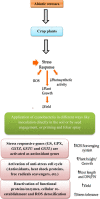Cyanobacteria as a Valuable Natural Resource for Improved Agriculture, Environment, and Plant Protection
- PMID: 37192997
- PMCID: PMC10156578
- DOI: 10.1007/s11270-023-06331-7
Cyanobacteria as a Valuable Natural Resource for Improved Agriculture, Environment, and Plant Protection
Abstract
Taking into consideration, the challenges faced by the environment and agro-ecosystem make increased for suggestions more reliable methods to help increase food security and deal with difficult environmental problems. Environmental factors play a critical role in the growth, development, and productivity of crop plants. Unfavorable changes in these factors, such as abiotic stresses, can result in plant growth deficiencies, yield reductions, long-lasting damage, and even death of the plants. In reflection of this, cyanobacteria are now considered important microorganisms that can improve the fertility of soils and the productivity of crop plants due to their different features like photosynthesis, great biomass yield, ability to fix the atmospheric N2, capability to grow on non-arable lands, and varied water sources. Furthermore, numerous cyanobacteria consist of biologically active substances like pigments, amino acids, polysaccharides, phytohormones, and vitamins that support plant growth enhancement. Many studies have exposed the probable role of these compounds in the alleviation of abiotic stress in crop plants and have concluded with evidence of physiological, biochemical, and molecular mechanisms that confirm that cyanobacteria can decrease the stress and induce plant growth. This review discussed the promising effects of cyanobacteria and their possible mode of action to control the growth and development of crop plants as an effective method to overcome different stresses.
Keywords: Abiotic stress; Molecular mechanisms; Phytohormones; Plants; Soils.
© The Author(s) 2023.
Conflict of interest statement
Competing InterestsThe authors declare that they have no known competing financial interests or personal relationships that could have appeared to influence the work reported in this paper.
Figures





References
-
- Abo-Shady AM, Osman MEH, El-Nagar MMF. Amelioration of the toxic effect induced by herbicide granstar on barley yield by the cyanobacterium Nostoc muscorum. Middle East Journal of Agriculture Research. 2018;7:1465–1472.
-
- Abdelsalam I, Elshobary M, Eladawy M, M., & Nagah, M. Utilization of multi-tasking non-edible plants for phytoremediation and bioenergy source-a review. Phyton. 2019;88(2):69–90. doi: 10.32604/phyton.2019.06831. - DOI
-
- Abou-El-Souod GW, El-Sheekh MM. Biodegradation of basic fuchsin and methyl red by the blue-green algae Hydrocoleum oligotrichum and Oscillatoria limnetica. Environmental Engineering and Management Journal. 2016;15(2):279–286. doi: 10.30638/eemj.2016.028. - DOI
-
- Ahmad R, Bilal M, Jeon JH, Kim HS, Park YI, Shah MM, Kwon SY. Improvement of biomass accumulation of potato plants by the transformation of cyanobacterial photorespiratory glycolate catabolism pathway genes. Plant Biotechnology. 2016;10:269–276. doi: 10.1007/s11816-016-0403-x. - DOI
-
- Al-Amin A, Parvin F, Chakraborty J, Kim YI. Cyanobacteria mediated heavy metal removal: a review on the mechanism, biosynthesis, and removal capability. Environmental Technology Reviews. 2021;10(1):44–57. doi: 10.1080/21622515.2020.1869323. - DOI
LinkOut - more resources
Full Text Sources
